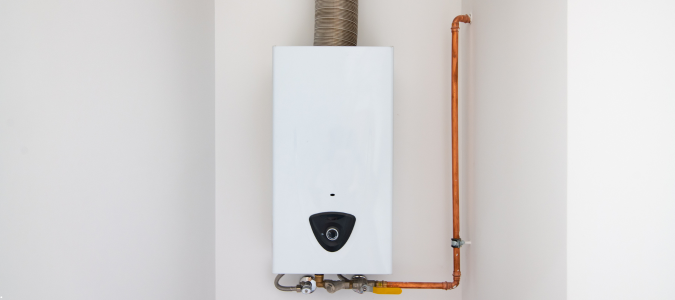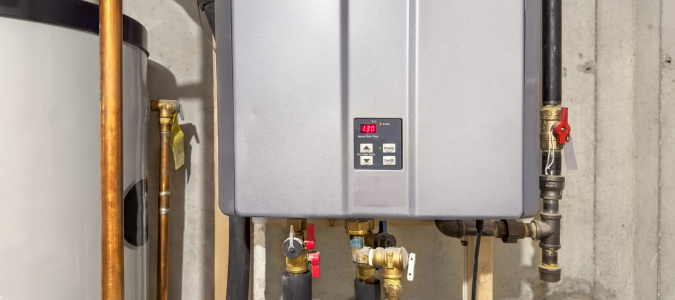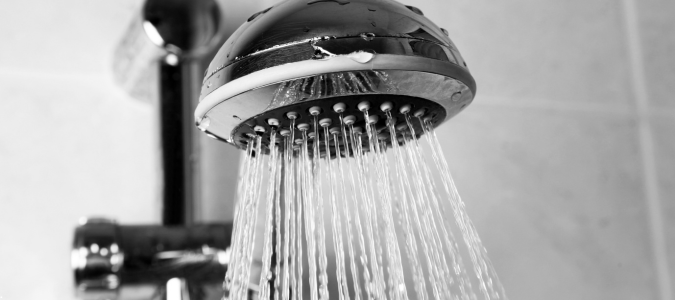Key Takeaways
Tankless water heaters deliver energy-efficient, on-demand hot water and can save space and money, but they’re not the right fit for every home. This guide breaks down how they work and what to consider before upgrading.
Are you considering making the switch to a tankless water heater? Before you dive in, there are a few things that you should know about how tankless water heaters work.
First, you should understand the difference between a tankless water heater and a tank water heater. The main, most obvious difference is how water is stored. A traditional water heater stores water in a large, insulated tank. It keeps the water continuously hot so that it’s always ready when you need it.
Tankless water heaters, on the other hand, do not store water. Instead, they heat water on demand. For example, when you turn on your hot water tap, cold water flows through the system and is heated by either a burner or electricity.
The biggest perk of a tankless water heater is that it’s much more energy-efficient than a traditional tank heater. Over time, you can save a ton of money on your energy bill.
Tankless water heaters also take up less space, have a lower carbon footprint and last longer than traditional water heaters. Finally, since water is not stored, tankless water heaters never run out of hot water.
Keep reading to learn more about how tankless water heaters work and if switching to one is the right choice for you and your home.
What is a Tankless Water Heater?
A tankless water heater is a water heating system that heats water on demand rather than storing hot water in a tank.
Traditional water heaters store between 30 and 80 gallons of water, while tankless water heaters store none. Another key difference is that tank water heaters run all the time to keep the stored water hot. Meanwhile, tankless water heaters only use energy when you turn on a hot water tap.
How long do tankless water heaters last? Tankless water heaters last up to 20 years, which is a much longer lifespan than tank water heaters, which typically last between 10 and 15 years.
Another perk of tankless water heaters is that they are compact wall units and take up less space than large tank heaters.
Step-by-Step: How a Tankless Water Heater Works
There are five steps that tankless water heaters cycle through every time you turn on your hot water tap:
- Water Flow Detection: When a hot water tap is turned on, cold water enters the system and triggers a flow sensor.
- Activation: The flow sensor activates the heating element, either a gas burner or an electric coil, depending on your tankless water heater type.
- Heat Exchange: As water passes through the heat exchange coils, it’s rapidly heated to the set temperature.
- Delivery: The heated water is delivered directly to the faucet, without being stored in a tank.
- Shutoff: When the hot water tap is turned off, the system automatically shuts down until it’s needed again.
Tankless Water Heater Maintenance Tips
One of the biggest advantages of a tankless water heater is that it requires much less maintenance than traditional tank heaters. Without a tank, you don’t have to worry about water heater leaks or corrosion.
However, some maintenance is still required to keep your tankless water heater running efficiently for as long as possible.
For example, you should have a professional descale your system annually. They do this by flushing vinegar or a descaling solution through the unit. This removes calcium and magnesium buildup, which is especially important if you have hard water.
Professionals follow these steps to flush your system:
- Turn off the power to the heater
- Close the inlet cold water valve and the outlet hot water valve
- Attach hoses to the valve and run a pump to circulate the descaling solution for about an hour
- Flush the system with cold water
- Reopen the valves and restore power to the heater
Another necessary maintenance routine is cleaning the filter. You should do this every few months to avoid a buildup that could restrict water flow.
There are a few signs to look out for that indicate your tankless system needs maintenance. If you have fluctuating or inconsistent water temperatures, reduced water flow, delayed hot water delivery or higher-than-normal energy bills, your system likely needs a tune-up.
Why You Should Hire a Professional for Installation and Maintenance
Proper installation is crucial for the longevity of your tankless water heater. This is another reason why it’s best to leave it up to the professionals. In fact, faulty installation can compromise the validity of your warranty, which is a risk you want to avoid.
If your tankless water heater is malfunctioning, the best first step is to contact a plumber. For example, is your water heater making noises? An expert can efficiently identify the problem and find the solution.
Professional plumbers have the expertise and experience needed to keep your tankless water heater running for up to 20 years. Plus, they can provide guidance on a routine maintenance schedule that can help prevent common issues in the future.
Some tankless water heater issues especially require expert intervention, including:
- Gas line modifications
- Venting and electrical requirements
- Sizing for household usage
If you’re experiencing issues with your tankless water heater or want to get ahead on maintenance, working with a professional is the best way to go.
Choosing a Tankless Water Heater: Quick Reference Guide
Several factors influence whether a tankless water heater is the right choice for your home. These include household size, water usage patterns and the type of energy available to you.
Household Size
Is a Tankless Water Heater a Good Fit?
Water Usage Patterns
Energy Availability
The bottom line is that tankless water heaters are an excellent choice for smaller households. They are known for efficiently heating water and helping reduce energy bills. Larger households can still benefit from tankless water heaters, but some adjustments will likely be necessary to meet the increased hot water demand.
Pros and Cons at a Glance
The pros of switching to a tankless water heater include being more energy-efficient than traditional heaters, saving money over time and saving space. Plus, they offer endless hot water, rather than being limited by the amount of water in the tank.
The cons of installing a tankless water heater are that they have a higher upfront cost, installation is complex and older homes may require upgrades.
The Smarter Way to Heat Water
The beauty of tankless water heater systems is that they only heat water when needed. They save energy, space and money over their 20-year lifespans, making them a worthwhile investment.
Before you switch water systems, it’s important to consult with a licensed plumber. They can evaluate your home and advise you on whether or not a tankless system is a good fit. This evaluation can save you time, money and headaches, so don’t skip getting an expert opinion.
ABC Can Take Care of All Your Tankless Water Heater Needs
Curious about making the switch? Contact ABC Home & Commercial Services for a free in-home evaluation today.
If your home is a good fit for a tankless water system, ABC can take care of the installation and maintenance for you. This way, you can enjoy on-demand hot water without a second thought.




